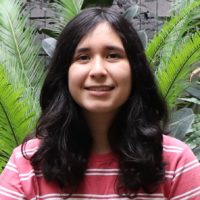
“Probing Nuclei in Insect and Plant Cells”
Project Summary:
The nucleus is an integral cellular structure that protects and organizes the eukaryotic genome. While the role of the nucleus has been well characterized, less is known about factors that can potentially impact features of nuclear architecture including size, shape, and stiffness; even less is known for non-mammalian organisms. Through two experiments, we have investigated 1) the correlation of genome size and repetitive DNA content to nuclear stiffness across three different insect species; and 2) the impact of disrupting the nuclear lamina (through mutations in NMCP genes) on nuclear size and shape in tomato.
To gauge how nuclear stiffness is affected by the size of the genome and the fraction of repetitive DNA it contains, we cultured cell lines from three different insect taxa and analyzed nuclear stiffness. Well-separated cells adhered to a glass surface were probed individually using a nanoindentation device mounted on an epifluorescence microscope. Our preliminary evidence suggests that a simple correlation does not exist between the genome size and nuclear stiffness of insects.
To study the role the plant nuclear lamina plays in governing nuclear architecture compared to the mammalian nuclear lamina, we raised tomato plants with mutations in the plant laminar protein-encoding NMCP genes to create three mutant genotypes whose nuclei could be analyzed. In doing so, we found that nuclei in mutant tomato guard and epithelial cells vary significantly from their wild-type counterparts, becoming more spherical in shape – a result different from that observed in comparable mammalian nuclei with nuclear lamina defects.
My Experience:
The time I spent as a summer intern in Dr. Eric Richards’ lab at BTI has been one of the most rewarding experiences of my academic life, maturing me not only as a researcher but as an individual. With Eric’s mentorship and the support of our research community, I applied my prior experiences in biophysics to contribute to three projects and developed new lab skills in cell biology and genetics.
In addition, I engaged in professional development events, from attending weekly research presentations to exploring different graduate programs through Cornell’s DGS event. Through these opportunities, I was exposed to various research fields and met with faculty to learn more about their career paths.
Outside of work, I found solace in connecting with other interns and experiencing the summer together. Although our time together was short, the friendships I have formed through BTI’s PGRP are ones that will span beyond Ithaca.
